 |
Traditionalist Issues
The Phenomenology of von Hildebrand and
His Novel Teaching on Marriage
Randy Engel
How original is the Theology of the Body? Did it originate solely with Wojtyla (later Pope John Paul II), or were there others who helped shape his new configuration for Catholic marriage?
Many of the major premises and themes of TOB are not original to Wojtyla.
By the time Wojtyla delivered his talks on Love and Responsibility at the University of Lublin in 1958 and 1959, there was already a strong movement in certain Catholic circles to realign Catholic marriage along more ‘personalist’ lines, led in part by the German philosopher Dietrich von Hildebrand and the German Benedictine priest Dom Herbert Doms.
Dietrich von Hildebrand was a phenomenologist like Wojtyla was he not? (1)
Yes. From 1909 to 1911, von Hildebrand was a student of Edmund Husserl, the founder of phenomenology at the University of Göttingen, but his philosophical mentor and friend was Adolf Reinach, a jurist and phenomenologist who later applied Husserl’s philosophy to law, philosophy, morals and ethics, but along more "objective" and "realistic" lines. (2)
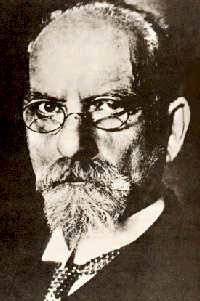
Husserl, the Lutheran founder of Phenomenology |
Also, Max Scheler, the German phenomenologist who taught at the University of Munich, played an important role in von Hildebrand’s early intellectual formation. (3) Von Hildebrand credits Scheler with his conversion to Catholicism, although Scheler himself left the Church in 1924. Both men were part of the well-known phenomenological circles that developed at the University of Munich and the University of Göttingen, but in the end each followed a different path. The influence of Scheler upon the young Wojtyla has already been noted earlier in this series.
Like Wojtyla, Von Hildebrand attempted to form an original philosophical system which incorporated contemporary philosophies including phenomenology and personalism. He believed that the new system offered valuable insights and truths which could be used to form a truly Christian Humanism and make the Gospel more fully intelligible to the modern world. (4)
John H. Crosby, founder of the Dietrich von Hildebrand Legacy Project, says von Hildebrand “…contributed to a new Christian humanism in which all human goods and values are redeemed. This humanism can be seen in his rich philosophy of love; for he does not think that only Christian love of neighbor counts as love, but he takes seriously all the kinds of human love, giving particular attention to the love between man and woman.” (5)
When did von Hildebrand’s begin to formulate his new theology of marriage?
According to his widow, Alice von Hildebrand, her husband had acquired a special interest in human love and conjugal relationships long before his conversion to Roman Catholicism in April of 1914 at the age of 30. (6)
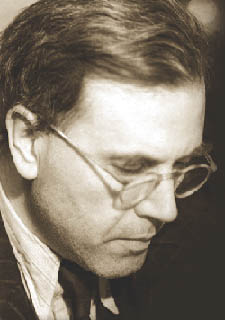
As a young man, Hildebrand defended that love was as important as procreation in marriage
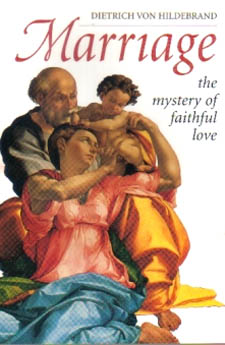 |
In 1923 he delivered a lecture on marriage and the value of conjugal sex in Ulm Germany on the occasion of a meeting of the Catholic Academic Association. In 1925 he delivered a similar address in Innsbruck, Austria, to the Federation of Catholic Students’ Unions. In these lectures he argued that there was a distinction between love as the meaning of marriage and procreation as its purpose or end. In his work, Marriage: The Mystery of Faithful Love, von Hildebrand states that “As marriage is, in its nature, principally a communion of love, so the meaning of physical consummation is not restricted to its function as a means of procreation. … But this primary end is not the only meaning of the physical act. Subjectively speaking, it is not even its primary meaning (bold type added).” (7)
Von Hildebrand taught that, “The marital embrace - a sacrament – has its own value, but to choose to sever it from the fruitfulness that God has linked to it, is a grave sin which inevitably saps the beauty of the mutual self-donation of the spouses. (8) He insisted that, “The marital embrace is the sacrament, not procreation.” (9)
In fact, the seventh sacrament of the Church is Matrimony, not conjugal sex. The very definition of the word “matrimony” is derived from the fact that the principal object which a female should propose to herself in marriage is to become a mother; or from the fact that to a mother it belongs to conceive, bring forth and train her offspring. As confirmed in the Catechism of Trent, the Christian sacrament of Matrimony is sealed when the husband and wife freely give their mutual consent in an exchange of vows of life-long fidelity and exclusiveness, each yielding to the other dominion over the other's body. (10)
Alice Von Hildebrand says that her husband believed that the Church’s position on the procreation and education of children as the primary end of marriage diminished the value of the interpersonal and unitive aspects of marriage, and that it was timely and necessary to introduce a corrective to remedy the situation. (11)
Crosby, who directs the Legacy Project to promote the philosophy and works of Dietrich Von Hildebrand concurs:
For centuries Catholic writers had stressed almost exclusively the procreative meaning of the marital act. Von Hildebrand was one of the first to see that, over and above the procreative meaning, there is also the unitive meaning of the marital act - the enactment of the love of the spouses for each other. … With his writings on man and woman in the 1920s, he prepared the ground in the Church for the teaching of Vatican II on the dual meaning of the marital act (bold type added). (12)
What was the reaction of Church officials to von Hildebrand’s views on the centrality of the marital embrace over and beyond the procreative purpose of marriage?
Alice von Hildebrand says her husband was conscious that “he was breaking new ground in making so explicit the distinction between the purpose and the meaning of marriage,” so he turned to Eugenio Cardinal Pacelli, then the Papal Nuncio in Munich, whom he had befriended, for confirmation of his views. She says that her husband “received from the future Pontiff a full endorsement of his position.” (13)
However, as is clear from Casti Connubii written in 1930, the Holy See did not endorse the paradigm shift in marriage as entertained by von Hildebrand. In his encyclical, Pope Pius XI clearly cites the 1917 Code of Canon Law formulation based on the writings of Saint Thomas and Saint Augustine - “The primary end of marriage is the procreation and the education of children.” (14)
Furthermore, as we shall document shortly, after Pacelli ascended the papal throne as Pius XII in 1939, he changed his earlier opinions which were said to have favored a ‘personalist’ view of marriage. The radical writings on marital sex by the German priest Dom Herbert Doms may have forced his hand on the matter. What was Father Herbert Doms’ teaching on the purpose of marriage?
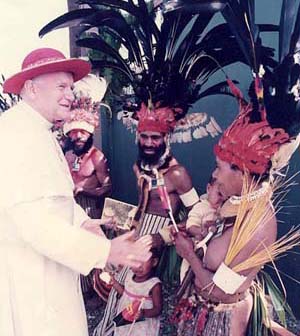
Theology of the Body: above, JPII greets a semi-nude native woman |
Father Herbert Doms, a philosopher and theologian and an admirer of Max Scheler, gave primacy to conjugal love (sex) over childbearing. In 1935 he wrote Vom Sinn and Zweck der Ehe, (About the Meaning and Purpose of Marriage), in which he claimed that sexual union, which makes possible the total gift of self, was the aim of marriage. He argued that since every act of coitus does not result in offspring, the primary purpose of conjugal sex must lay outside of procreation, that is, in the personal fulfillment of man and woman as persons:
"In the perfect act, worthy of human beings, the two partners grasp each other reciprocally in intimate love; that is, spiritually they reciprocally give themselves in an act which contains the abandonment and enjoyment of the whole person and is not simply an isolated activity of organs." (15)
Doms taught that the dignity of the sexual act is rooted in its unitive rather than its procreative meaning and that this principle of unity is derived from the nature of conjugal love and not from any connections external to the spouses, such as children. (16) Like Wojtyla, he emphasized the sexual act as a “gift” from one person to another. (17) For the record, Doms, like von Hildebrand, opposed contraception.
Doms taught that the physical union in marriage completed the moral participation in the life of the other, just as physical union with Christ in the Eucharist completed the moral union with Christ. (18)
Did the Holy See take action against Father Doms?
Yes. As early as 1939, the Holy Office ordered the removal of Doms’ doctrinally unsafe work from public circulation and sales. (19)
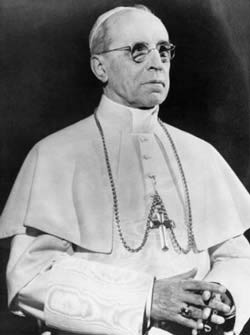
Pius XII re-affirmed the Church teaching on the primary end of marriage |
On April 1, 1944, under Pope Pius XII, the Holy Office issued a decree on the ends of marriage which specifically rejected the thesis put forth by Doms and others that the secondary ends of marriage can be considered as independent from the primary end and not subordinated to it. Even though Doms was not specifically named in the pronouncement, it was understood that the edict was a repudiation of his opinions on the matter. (20)
And on October 29, 1951, at the end of his famous “Address to Members of the Congress of the Italian Association of Midwives,” Pius XII warned against an inversion of the Church’s formulation on the ends of marriage - a warning that was applicable, in part, to both Doms’ and von Hildebrand’s new theology of marriage.
Here are the pope’s main arguments in favor of the traditional formulation of the primary and secondary ends of marriage and in opposition to the teachings that put “personalism” on an equal and independent footing with procreation and the institution of family life:
“Personal values” and the need to respect such are a theme which, over the last twenty years or so, has been considered more and more by writers. In many of their works, even the specifically sexual act has its place assigned, that of serving the “person” of the married couple. The proper and most profound sense of the exercise of conjugal rights would consist in this, that the union of bodies is the expression and the realization of personal and affective union. …The primary end of marriage
Now, the truth is that matrimony, as an institution of nature, in virtue of the Creator’s will, has not, as a primary and intimate end, the personal perfection of the married couple but the procreation and upbringing of a new life. The other ends, inasmuch as they are intended by nature, are not equally primary, much less superior to the primary end, but are essentially subordinated to it. This is true of every marriage, even if no offspring result, just as of every eye it can be said that it is destined and formed to see, even if, in abnormal cases arising from special internal or external conditions, it will never be possible to achieve visual perception (bold type added).
It was precisely to end the uncertainties and deviations which threatened to diffuse errors regarding the scale of values of the purposes of matrimony and of their reciprocal relations, that a few years ago (March 10, 1944), We Ourselves drew up a declaration on the order of those ends, pointing out what the very internal structure of the natural disposition reveals. We showed what has been handed down by Christian tradition, what the Supreme Pontiffs have repeatedly taught, and what was then in due measure promulgated by the Code of Canon Law.
Not long afterwards, to correct opposing opinions, the Holy See, by a public decree, proclaimed that it could not admit the opinion of some recent authors who denied that the primary end of marriage is the procreation and education of the offspring, or teach that the secondary ends are not essentially subordinated to the primary end, but are on an equal footing and independent of it (bold type added).
Would this lead, perhaps, to Our denying or diminishing what is good and just in personal values resulting from matrimony and its realization? Certainly not, because the Creator has designed that for the procreation of a new life human beings made of flesh and blood, gifted with soul and heart, shall be called upon as men, and not as animals deprived of reason to be the authors of their posterity. It is for this end that the Lord desires the union of husband and wife. Indeed, the Holy Scripture says of God that He created man to His image and He created him male and female, and willed—as is repeatedly affirmed in Holy Writ—that “a man shall leave mother and father, and shall cleave to his wife: and they shall be two in one flesh.”
All this is therefore true and desired by God. But, on the other hand, it must not be divorced completely from the primary function of matrimony—the procreation of offspring. Not only the common work of external life, but even all personal enrichment—spiritual and intellectual—all that in married love as such is most spiritual and profound, has been placed by the will of the Creator and of nature at the service of posterity. The perfect married life, of its very nature, also signifies the total devotion of parents to the well-being of their children, and married love in its power and tenderness is itself a condition of the sincerest care of the offspring and the guarantee of its realization. … (bold type added) (21)
Did John Paul II ever acknowledge either Doms or von Hildebrand for their contributions to his own master work – the Theology of the Body?
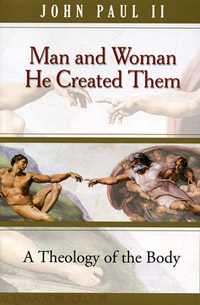
JPII stated von Hildebrand's writings heavily influenced his "master work" |
The pope never publicly mentioned Doms in connection with TOB, but from just the few quotes mentioned above, one can see many similarities between John Paul II’s TOB and Doms’ Vom Sinn and Zweck der Ehe, with its heavy personalist emphasis on “self-giving” and conjugal sex as sacrament.
Regarding von Hildebrand’s influence on John Paul II, John Crosby states that the pope said that von Hildebrand’s writings on love and marriage heavily influenced his own master work, the Theology of the Body.” (22) Further, one cannot discount von Hildebrand’s important influence on Love and Responsibility, Gaudium et Spes and Humanae Vitae, three of the foundation works that John Paul II used to undergird his Theology of the Body.
This writer did not know von Hildebrand personally, but for many years has had the pleasure of knowing his widow, Alice. Von Hildebrand’s writings in opposition to classroom sex instruction, which he co-authored with Professor William Marra of Fordham University, are very good, but, on the question of marriage and its ends, I believe that von Hildebrand took a wrong and deadly turn in the road. (23)
Acting the role of Devil’s Advocate for the moment, from the very beginning of this series on TOB you have hammered away at the importance of the Church’s traditional formulation on the primary and secondary ends of marriage. Meaning – ends - primary – subordinate - what harm does a little verbal gymnastics do?
Well, I wish Saint Athanasius was here to answer that question. After all, he went to war against Arius and turned an empire upside down over just one word, “homoousios” – the one word that could not be understood to mean what the Arians meant.(24)
Let me repeat the words of Pope Pius XII –The truth is that matrimony, as an institution of nature, in virtue of the Creator’s will, has not as a primary and intimate end the personal perfection of the married couple but the procreation and upbringing of a new life. The other ends, inasmuch as they are intended by nature, are not equally primary, much less superior to the primary end, but are essentially subordinated to it.”
In short, Pius XII is reminding ‘modern man’ that matrimony and sexual relations, by God’s will, are about babies and raising a family.
For while it is true that sacramental marriage is more than solely a vehicle to reproduce offspring, it is never less than that. The problem with von Hildebrand and Doms and other personalists is not that they advance love, unity and fidelity within marriage, but that they do so at the expense of undermining or denying the objective order and the true end of marriage, which is the procreation and the education of children.
1. Dietrich von Hildebrand was born in Florence, Italy on October 12, 1889, the only son of the famous German sculptor Adolf von Hildebrand. He grew up in an affluent, cosmopolitan European environment that later centered in Munich, Germany. He came to the United States in 1940 with financial assistance from the Rockefeller Foundation and taught at Fordham University until his retirement in 1959. He died on January 26, 1977.
2. For biographical information on Edmund Husserl, a Jewish convert to Lutheranism under whom von Hildebrand completed his Ph.D., click here. For an excellent biographical sketch of Adolf Reinach, whom von Hildebrand first befriended in Munich in 1907, click here.
3. Scheler and von Hildebrand first met at a party in 1907, shortly after the former had joined the teaching staff at the University of Munich. Von Hildbrand was 17 years old at the time. Scheler’s inner philosophical circle included Edmond Husserl, Theodor Lipps, Johannes Daubert, Theodor Conrad, Hedwig Conrad-Martius, Alexander Pfaender, Alexandre Koyre, student Edith Stein and, of course, von Hildebrand. Edith Stein, a Jewess, converted to Catholicism in 1922 and eventually entered the the Carmelite Order. She was canonized on October 11, 1998 as St. Teresa Benedicta of the Cross, confessor and martyr, by Pope John Paul II. In 1910, Scheler lost his position at the University after he was accused of adultery and the charge was upheld by the courts. In 1912, he married for the second time. Scheler died in 1928 at the age of 54.
4. See comments of Pope Benedict XVI praising the “personalism” of Von Hildebrand here. Many Church Fathers including Saint Ambrose, Saint Augustine and Saint Thomas were influenced by and used non-Catholic sources, but they never compromised Church teachings on faith and morals in doing so.
5. Ibid.
6. Alice von Hildebrand, “Introduction - Marriage: the Mystery of Faithful Love” at http://catholiceducation.org/articles/marriage/mf0003.html.
7. Dietrich Von Hildebrand, Marriage: The Mystery of Faithful Love, excerpt online at http://www.ewtn.com/library/Marriage/SIPMARRG.HTM.
8. Alice von Hildebrand, “Personalist Responds to Critic of Paul VI,” Pro Ecclesia, 2002, Vol. XXXIII No. 3, p. 7.
9. Ibid.
10. See http://www.catholicbook.com/AgredaCD/Trent/tsacr-m.htm: “Hence pastors should teach the faithful that the nature and force of marriage consists in the tie and obligation; and that, without consummation, the consent of the parties, expressed in the manner already explained, is sufficient to constitute a true marriage. It is certain that our first parents before their fall, when, according to the holy Fathers, no consummation took place, were really united in marriage. Hence the Fathers say that marriage consists not in its use but in the consent. This doctrine is repeated by St. Ambrose in his book On Virgins.”
11. Alice von Hildebrand, “Introduction… .”
12. Crosby.
13. Alice von Hildebrand., “Introduction… .”
14. Casti Connubii, 17.
15. John T. Noonan, Contraception: A History of Its Treatment by the Catholic Theologians and Canonists, Harvard University Press, Cambridge, 1966, p.497.
16. Rolando B. Arjonillo Jr., Conjugal Love and the Ends of Marriage – A Study of Dietrich von Hildebrand and Herbert Doms in the Light of the Pastoral Constitution Gaudium et spes, European University Studies, Series XXIII, Vol./Band 619, Peter Lang, Bern, 1998, p. 160.
17. Ibid. 171.
18. Noonan, p. 498.
19. Arjonillo, p. 227.
20. Ibid., p. 224.
21. For full text of Pope Pius XII’s “Address to Midwives” click here.
22. Stephanie Tracy, “Resurrecting a thinker,” Arlington Catholic Herald, January 31-February 6, 2008.
23. I am joined in this opinion by Dr. Herbert Ratner, the great prolife physician and defender of family life from Oak Park, Ill. In private conversations during the early 1970s, he was the first to alert me to the dangers of von Hildebrand’s new thinking on marriage which he (Ratner) believed would ultimately destabilize marriage and undermine the value of children and family life.
24. See Elvis Rowan website.

Posted September 12, 2008
This article-interview is an excerpt from the Part IV of a seven-part series entitled
"John Paul II and the Theology of the Body – A Study in Modernism" by Randy Engel.
She is a Catholic author and director of the US Coalition for Life.
Part IV, titled “Dealing with a Stacked Deck” was published in the August edition of
Catholic Family News magazine.

Related Topics of Interest
 Wojtyla Influenced by Theosophist Helena Blavatsky Wojtyla Influenced by Theosophist Helena Blavatsky
 Philosophy Then and Now Philosophy Then and Now
 The Unfounded Haste of JPII in Approving Evolution The Unfounded Haste of JPII in Approving Evolution
 The Perplexing Pontificate of JPII The Perplexing Pontificate of JPII
 The Canonization of JPII: the Moral Free Pope The Canonization of JPII: the Moral Free Pope
 Liberals, Modernists, and Progressivists Liberals, Modernists, and Progressivists

|
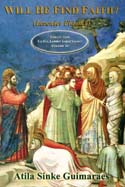
Traditionalism | Hot Topics | Home | Books | CDs | Search | Contact Us | Donate

© 2002- Tradition in Action, Inc. All Rights
Reserved
|
 |
|
